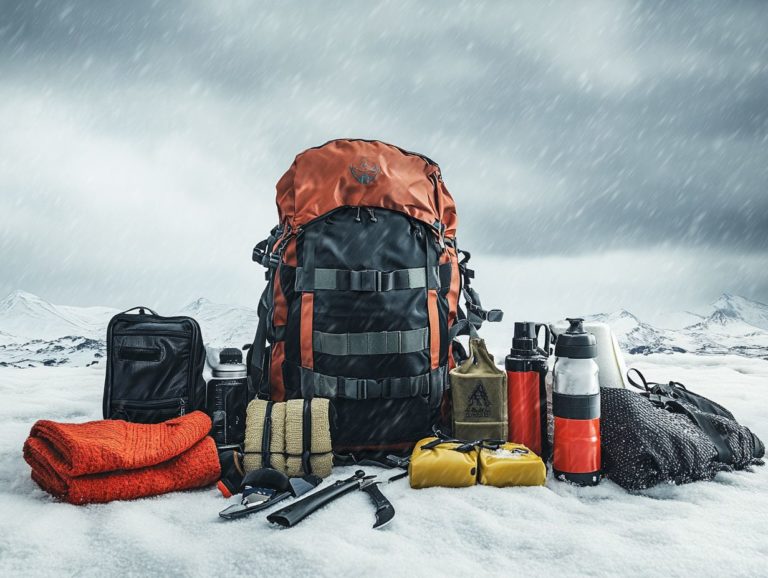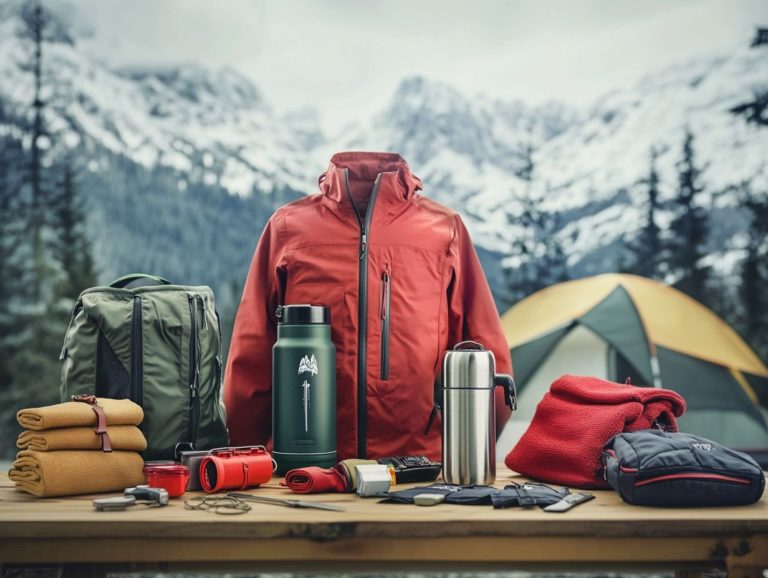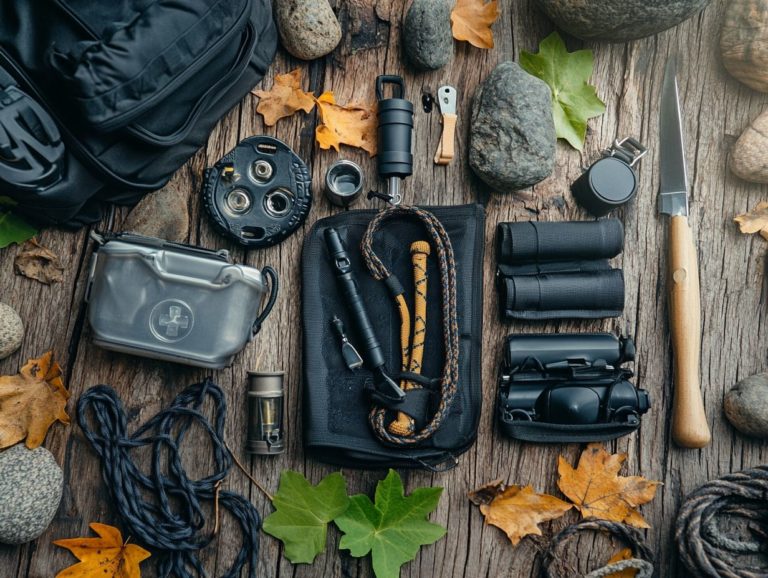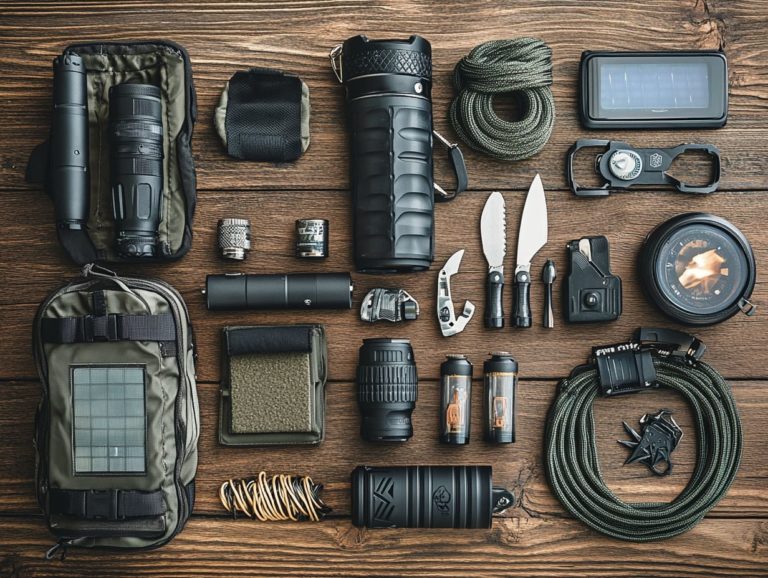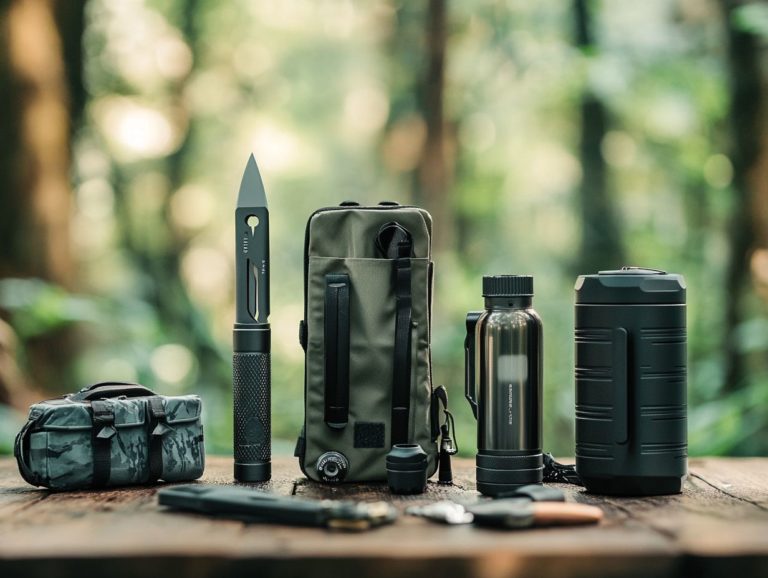The Importance of Shelter in Survival Gear
Shelter stands as a fundamental pillar of survival, offering not only protection from the elements but also a safe haven during life s challenging moments.
This exploration delves into the essential nature of shelter, comparing both natural and man-made options while weighing their respective advantages and disadvantages in survival. It presents key factors for you to consider when selecting the right shelter and guides you through the building process.
You ll also discover alternative solutions such as tents and tarps that may suit your needs.
Shelter plays a vital role in long-term survival, especially in extreme conditions and natural disasters. Get ready to boost your survival skills!
Contents
- Key Takeaways:
- The Role of Shelter in Survival
- Types of Shelter
- Factors to Consider When Choosing Shelter
- How to Build and Maintain Shelter
- Alternative Shelter Options
- Importance of Shelter in Long-Term Survival and Humanitarian Aid
- Frequently Asked Questions
- What is the importance of shelter in survival gear and humanitarian contexts?
- What are the different types of shelters in survival gear and transitional housing?
- Why is it essential to have a shelter in your survival gear?
- What factors should I consider when choosing a shelter?
- Can I make a shelter from natural materials, and what skills are necessary?
- How often should I check and replace my shelter?
Key Takeaways:
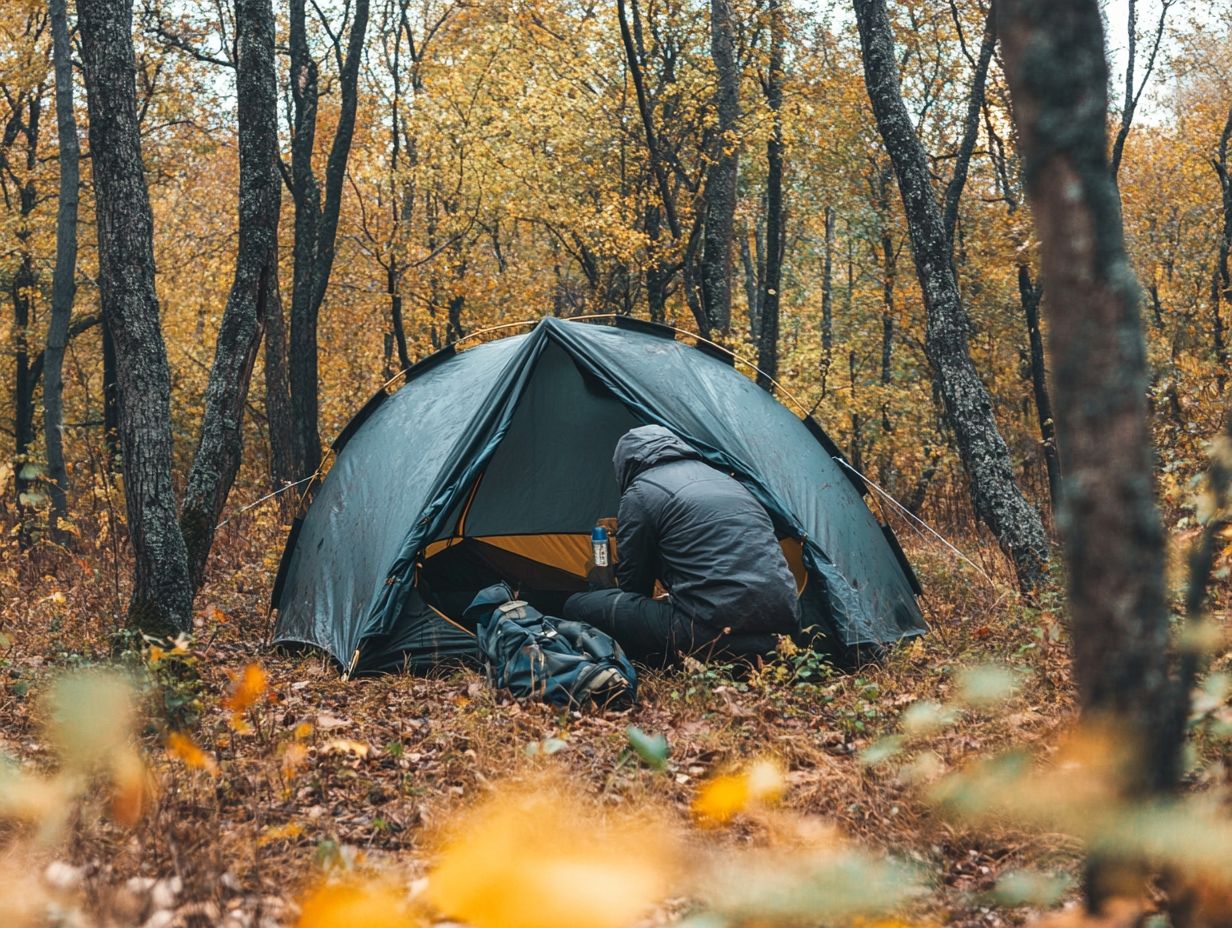
- Shelter is essential for survival as it protects us from the elements and provides safety.
- Consider factors like location, climate, and resources when choosing shelter.
- In emergencies, tents and tarps can offer temporary shelter and relief.
The Role of Shelter in Survival
Shelter is a cornerstone of human existence, embodying a fundamental need that guarantees safety and security amid the chaos of natural disasters and conflicts. Adequate housing shields you from harsh weather and fosters a sense of belonging and community resilience during turbulent times.
Humanitarian organizations play a key role in addressing the needs of people who have been forced to leave their homes, providing essential support for recovery efforts through various shelter solutions. This ensures that vulnerable populations can rebuild their lives and maintain their dignity even in the most challenging circumstances.
Why Shelter is Essential for Survival
Shelter is critical for your survival, offering protection against environmental hazards while ensuring the safety and security of you and your loved ones.
In the face of natural disasters like hurricanes, earthquakes, or floods, having a secure retreat becomes crucial for your physical safety and overall well-being. Humanitarian organizations respond during these times, promptly providing emergency housing solutions to affected individuals and communities, effectively minimizing further suffering.
Shelter also profoundly impacts mental health. A stable environment nurtures a sense of belonging and stability, both vital for emotional resilience. Thus, securing adequate shelter goes beyond mere survival; it plays a pivotal role in enhancing your quality of life. When preparing for outdoor adventures, consider the top features to look for in survival gear to ensure your safety and well-being.
Types of Shelter
Shelter can be divided into two primary categories: natural and man-made. Each type serves unique purposes, designed to meet the safety and survival needs of individuals across diverse environments.
Natural vs. Man-Made Shelter
Natural shelters, like caves and the cover of trees, offer immediate refuge from environmental threats, but they may not provide the same level of permanence and comfort that comes with man-made structures.
On the other hand, man-made shelters such as houses and cabins are built with durability and comfort in mind. They often feature insulation and modern amenities, creating a true sanctuary from the elements. While natural shelters can blend beautifully into their surroundings, fostering a unique connection to nature, they might fall short in terms of safety during harsh weather. To ensure your gear is effective during such conditions, understanding the importance of testing your survival gear is crucial, especially during heavy rainfall or extreme temperatures.
Consider this: a sturdy wooden cabin can withstand high winds more effectively than a crumbling cave. Ultimately, the decision between these two shelter types depends on your personal priorities, striking a balance between the allure of a natural experience and the essential need for safety and comfort.
Pros and Cons of Different Types

When evaluating different types of shelters, you should carefully weigh the pros and cons of natural versus man-made options, including transitional shelters. Each type brings unique advantages suited to various survival scenarios.
For example, natural shelters like caves or overhanging rock formations offer excellent protection from the elements. They significantly reduce the need for extensive construction. However, they may lack the adaptability that man-made options provide, such as tents or fortified structures, especially in extreme weather conditions.
Man-made shelters often allow for customization and enhanced insulation. However, setting them up can be tricky without the right equipment and a solid understanding of the environment. For those venturing outdoors, understanding the importance of survival gear is essential. Transitional shelters, while temporary, can serve a crucial role during periods of displacement. They might fall short in offering adequate security against wildlife or harsh climates.
Factors to Consider When Choosing Shelter
Selecting the ideal shelter requires careful consideration of several crucial factors. Location, climate, materials, and available resources are essential elements that significantly influence your safety and security.
Every aspect demands your attention to ensure that the shelter you choose meets your needs effectively.
Location and Climate
The location and climate play critical roles in determining your shelter’s suitability. They directly impact your safety and exposure to environmental hazards.
Various geographic elements, such as topography and proximity to water bodies, can greatly influence your shelter’s design and materials.
If you find yourself in an area prone to heavy rainfall, consider elevated structures to prevent flooding. In contrast, if you re in an arid region, insulation that minimizes heat gain could be your best friend.
Microclimates formed by surrounding hills or forests may provide protection against extreme weather, affecting your needs for warmth and ventilation.
Natural disaster risks like hurricanes or earthquakes add complexity to these decisions. Think about strong building techniques that can withstand harsh conditions. Easy access to resources and emergency services is also crucial, influencing both your daily living and potential evacuation routes.
Materials and Resources
The choice of materials and resources is pivotal when constructing your shelter. They dictate the safety, durability, and overall effectiveness of the structure against environmental challenges.
You ll discover that different materials such as wood, metal, and earth bring unique benefits and drawbacks, influenced by the surrounding environment.
Wood excels in insulation but can fall prey to pests, making it less favorable in humid climates. Metal boasts superior durability and fire resistance, yet it can become a heat trap under the sun’s glare.
Earthen materials, like adobe or cob, offer sustainability and excellent temperature regulation. However, they might struggle with structural integrity in regions experiencing heavy rainfall.
By exploring these options, you can create a tailored shelter design that aligns with your environment’s specific demands.
How to Build and Maintain Shelter
Constructing and sustaining a shelter requires a thoughtful blend of survival skills, technical knowledge, and the right supplies. These elements are essential to ensure your shelter remains functional and safe over the long term.
Start gathering your materials today to build a strong, safe shelter!
Step-by-Step Guide

This step-by-step guide lays out the essential procedures for building a shelter, focusing on the survival skills and materials you ll need for success, following the guidelines of civil protection.
Understanding the details of each phase is crucial for effective planning and execution. Your first step involves careful site selection; look for a location that offers natural protection from elements like wind and rain. Ideally, it should be close to a fresh water source.
Next, gather your materials branches, leaves, and stones will serve as your primary building blocks. Mastering construction techniques, such as creating a sturdy framework and insulating your shelter to retain heat, is key to ensuring safety and comfort in various environments.
This approach enhances your ability to survive and fosters a deeper connection to nature and the communities around you.
Alternative Shelter Options
Along with traditional shelters, you ll find that alternative options like tents, tarps, and specialized gear offer versatile solutions for a range of survival scenarios. These alternatives can adapt to your needs, ensuring you re well-prepared for whatever challenges may arise.
Using Tents, Tarps, and Other Gear
Utilizing tents, tarps, and other gear can provide you with effective and flexible shelter solutions, especially in emergency responses to natural disasters and humanitarian aid efforts.
In the aftermath of events like hurricanes or earthquakes, these temporary shelters offer immediate protection from the elements and create a safe haven for displaced individuals. Imagine having a quick, cozy spot to rest when disaster strikes!
Tents, available in various sizes and structures, can be quickly set up and easily transported, making them ideal for both personal and community use.
On the flip side, tarps are incredibly versatile; they can be adapted to shield you from rain or sun while still allowing for ventilation. While tents provide more privacy and sturdiness, they may require greater effort and time for setup and maintenance.
It’s crucial for you to consider these options carefully, as the right choice can greatly enhance your survival experience in challenging conditions.
Importance of Shelter in Long-Term Survival and Humanitarian Aid
The significance of adequate shelter in long-term survival cannot be overstated; it serves as a cornerstone for recovery and resilience of communities impacted by disasters or conflicts. Without this essential element, the path to rebuilding and thriving becomes increasingly challenging.
Surviving in Extreme Conditions
Surviving in extreme conditions demands specialized shelter techniques and materials that can endure harsh weather and environmental challenges.
Whether you’re contending with blistering heat, relentless rain, or bitter cold, mastering the art of creating a resilient shelter is vital for your safety and comfort.
Techniques such as elevating your structure off the ground can help stave off flooding in areas prone to heavy rain. Insulated materials like reflective tarps or heavy-duty insulation boards will shield you from intense cold.
Utilizing natural resources like branches and leaves for insulation not only boosts your comfort but also offers valuable camouflage in wilderness settings. Incorporate windbreaks using rocks or larger debris to dramatically diminish the force of gusty winds, making your survival experience much more manageable.
Frequently Asked Questions
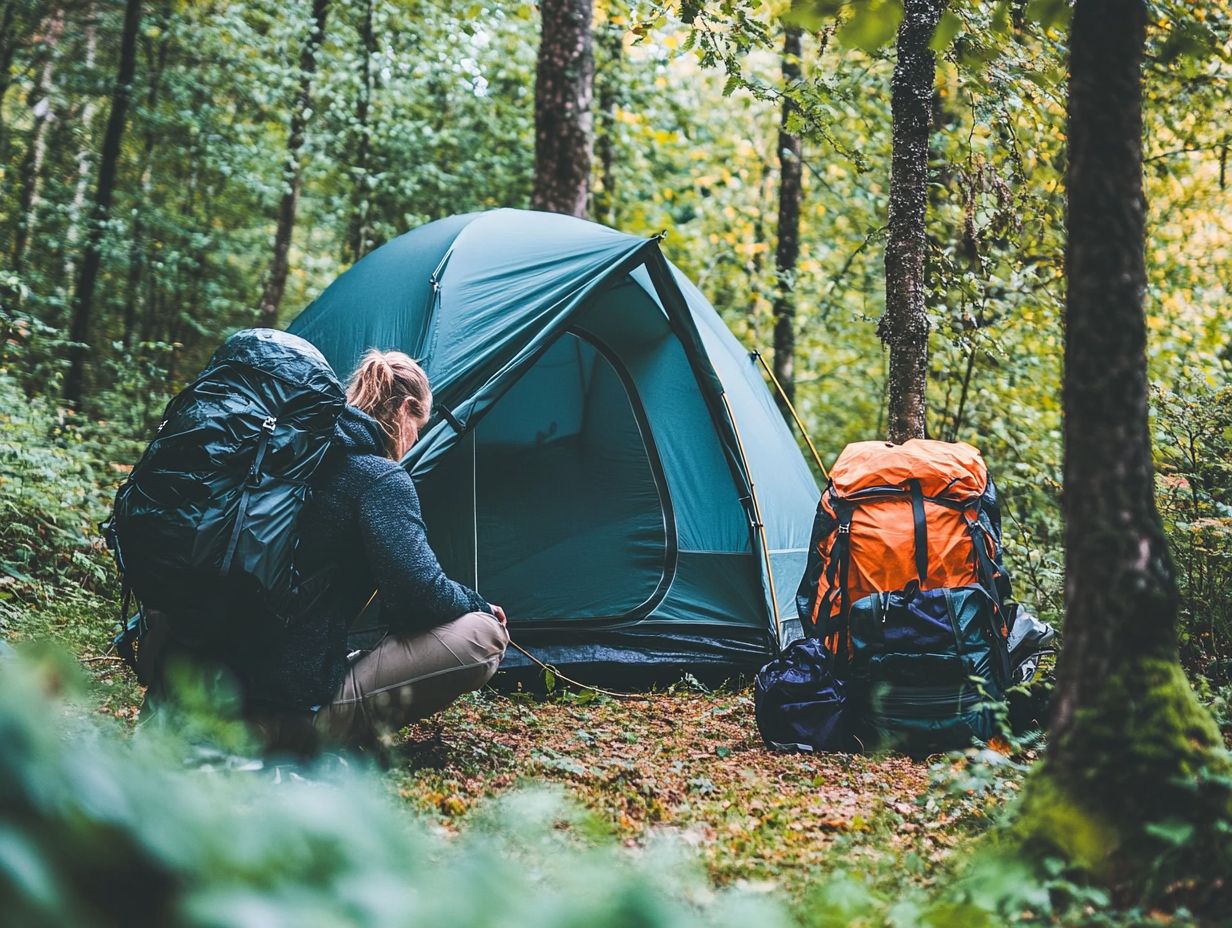
What is the importance of shelter in survival gear and humanitarian contexts?
Shelter is crucial for survival in extreme conditions. It protects you from harsh weather, insects, and other dangers while providing a sense of security and comfort.
What are the different types of shelters in survival gear and transitional housing?
There are various types of shelters, such as tents, tarps, bivvies (small, lightweight shelters for one person), and emergency blankets. Each has different features and benefits depending on the situation.
Why is it essential to have a shelter in your survival gear?
A shelter greatly boosts your chances of survival. It helps control your body temperature and provides a safe spot to rest and store supplies.
What factors should I consider when choosing a shelter?
Choose a shelter based on weather, terrain, and how many people it will accommodate. Ensure it is lightweight and easy to set up.
Can I make a shelter from natural materials, and what skills are necessary?
Yes, you can build a shelter from natural materials, like branches and leaves. However, this requires specific skills and knowledge.
How often should I check and replace my shelter?
Regularly check your shelter for damage or wear. Replace it every 1-2 years if you use it often or after any survival situation to ensure maximum reliability.

